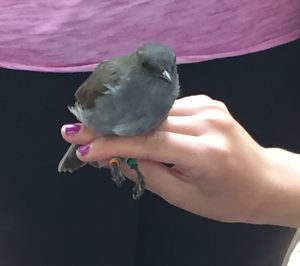Today we embarked on a terrestrial expedition to Hawai’i Volcanoes National Park. This was quite a change of speed from yesterday’s marine extravaganza, but we rose to the challenge. Our group set out in the early morning hours to venture to the Kipuka Puaulu Special Ecological Area. We were lucky enough to be guided by U.S. Geological Survey (USGS) biologist Katie Hooker. Our intrepid leader, Dr. Andy Read, explained he had been waiting for a trip like this for over a decade, so we knew we were in for a good trek.

Kīpuka is a Hawaiian word that refers to an island of vegetation that remains after a lava flow. These islands can be home to old-growth forests, such as Kipuka Puaulu, and are ecologically significant on many fronts. Kipuka Puaulu is a biologically rich area, full of native birds, plants, insects, and trees. The area is particularly known for bird watching, since it is home to a multitude of endemic species.

While in the old-growth forest, renown USGS scientist Dr. Paul Banko provided insights into how the local ecosystem has changed over time, and discussed current conservation studies and practices within the area. Unsurprisingly, invasive species have had negative effects on ecosystem structure and function. Dr. Banko’s team is currently in the second year of a project studying the effects of removing alien species (rats, yellow jackets and Argentine ants) on native birds and plants. The efforts of Dr. Banko and his team demonstrate on-the-ground dedication in preserving and restoring the native Hawaiian forest.

After getting the low-down on Kipuka Puaulu, we hiked off trail to meet several USGS interns who were bird banding. Our group’s bird-enthusiasts rejoiced, as we were able to help in the banding project. At half-hour intervals the interns checked for birds at various mist nets scattered throughout the forest. We were fortunate to accompany them on some of these runs and help to band much smaller birds than last week’s Laysan Albatross.

The USGS team captured several species of birds, including the common Japanese White-eye (Zosterops japonicus), ʻapapane (Himatione sanguinea), Hawai’i elepaio (Chasiempis sandwichensis), ʻōmaʻo (Myadestes obscurus), and northern cardinal (Cardinalis cardinalis). With the exception of the Japanese White-eye and northern cardinal, these birds are endemic to Hawai’i. The ʻōmaʻo was the star of the show, with the USGS crew having captured this species only once before at this location.

After several successful hours in the forest, we drove to a different portion of the National Park to meet with USGS research microbiologist, Dr. Carter Atkinson, who described some of the introduced diseases that threaten native Hawaiian birds, including avian malaria and pox. Our discussion with Dr. Atkinson reinforced the incredible pressures on the local ecosystems, and the very uncertain future of native Hawaiian flora and fauna.
After our meeting with Carter, we decided to go check out some major ‘hotspots’ of the National Park (pun very intentional). This included Kilauea Caldera and Nahuku (Thurston Lava Tube), a 500-year-old lava cave.

Quasi-overwhelmed by the crowds of tourists and tired from our early morning, we left the National Park for the day (we will be back on Thursday) to investigate Punalu’u Black Sand Beach where we were greeted by three green sea turtles (Chelonia mydas). Yet, as all good things must come to an end, we bid the turtles a farewell and hit the road back to Kona to get a good nights sleep.
